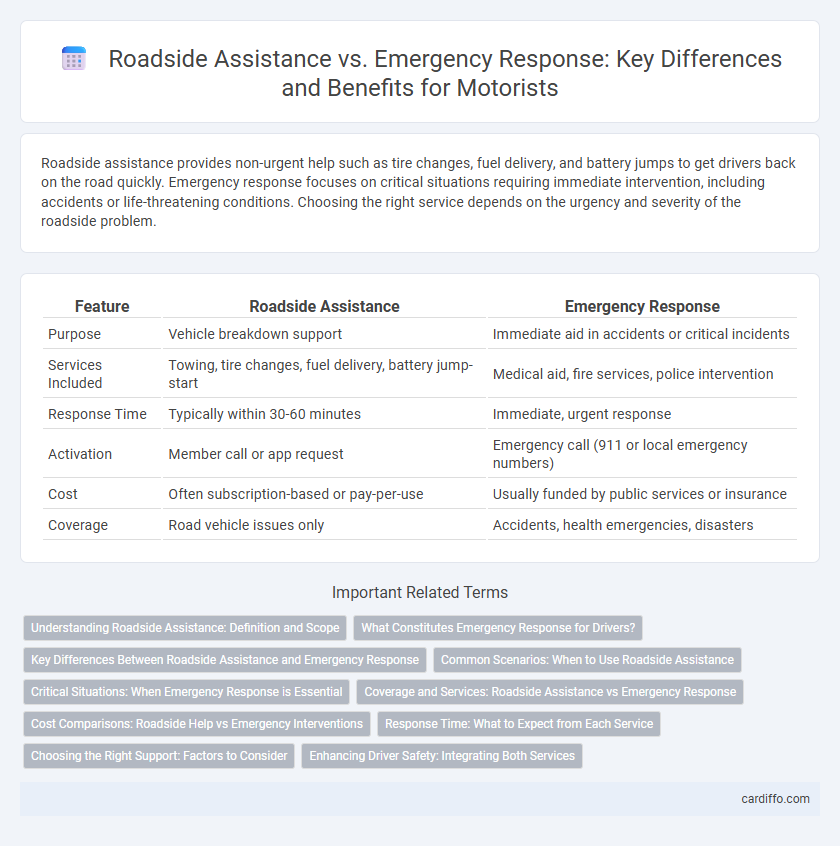Roadside assistance provides non-urgent help such as tire changes, fuel delivery, and battery jumps to get drivers back on the road quickly. Emergency response focuses on critical situations requiring immediate intervention, including accidents or life-threatening conditions. Choosing the right service depends on the urgency and severity of the roadside problem.
Table of Comparison
| Feature | Roadside Assistance | Emergency Response |
|---|---|---|
| Purpose | Vehicle breakdown support | Immediate aid in accidents or critical incidents |
| Services Included | Towing, tire changes, fuel delivery, battery jump-start | Medical aid, fire services, police intervention |
| Response Time | Typically within 30-60 minutes | Immediate, urgent response |
| Activation | Member call or app request | Emergency call (911 or local emergency numbers) |
| Cost | Often subscription-based or pay-per-use | Usually funded by public services or insurance |
| Coverage | Road vehicle issues only | Accidents, health emergencies, disasters |
Understanding Roadside Assistance: Definition and Scope
Roadside assistance refers to services provided to drivers experiencing vehicle breakdowns or malfunctions, such as flat tire changes, jump-starts, fuel delivery, and lockout help. Its scope covers non-life-threatening situations focused on restoring vehicle functionality and enabling safe travel continuation. Unlike emergency response, which addresses immediate safety and medical crises, roadside assistance aims primarily at convenient vehicle support and minimizing travel disruption.
What Constitutes Emergency Response for Drivers?
Emergency response for drivers encompasses immediate actions taken to address critical incidents such as accidents, medical crises, or hazardous road conditions requiring urgent intervention. It involves coordinated efforts from emergency services including police, fire departments, and paramedics to ensure safety, provide medical aid, and prevent further harm. Unlike roadside assistance, which handles non-life-threatening vehicle issues like flat tires or battery jumps, emergency response prioritizes life preservation and public safety in severe situations.
Key Differences Between Roadside Assistance and Emergency Response
Roadside assistance primarily offers non-emergency services such as tire changes, battery jump-starts, and fuel delivery to help drivers safely continue their journey. Emergency response involves immediate action by trained professionals to address severe incidents like accidents, injuries, or hazardous situations requiring medical attention or law enforcement. The key difference lies in the urgency and scope of services: roadside assistance focuses on vehicle-related minor issues, while emergency response handles life-threatening or critical emergencies.
Common Scenarios: When to Use Roadside Assistance
Roadside assistance is ideal for common vehicle issues like flat tires, dead batteries, or running out of fuel, providing quick help for non-life-threatening situations. Emergency response is reserved for serious incidents such as accidents, fires, or medical emergencies that require immediate professional intervention. Understanding these distinctions ensures timely and appropriate support during roadside challenges.
Critical Situations: When Emergency Response is Essential
Emergency response is essential in critical roadside situations involving severe injuries, life-threatening conditions, or hazardous material spills where immediate professional medical or safety intervention is required. Roadside assistance primarily handles non-life-threatening issues such as flat tires, battery jump-starts, and lockouts, offering convenience but not specialized emergency care. Recognizing the severity of the situation ensures that emergency responders are contacted promptly to provide critical care and manage potential dangers effectively.
Coverage and Services: Roadside Assistance vs Emergency Response
Roadside assistance primarily covers vehicle-related issues such as flat tires, battery jump-starts, fuel delivery, and lockout services, ensuring drivers get back on the road quickly. Emergency response encompasses broader, critical services including accident management, medical aid, fire control, and hazardous situation handling, prioritizing safety and immediate intervention. While roadside assistance focuses on convenience and vehicle immobilization, emergency response delivers comprehensive safety support in life-threatening or urgent scenarios.
Cost Comparisons: Roadside Help vs Emergency Interventions
Roadside assistance typically costs significantly less than emergency response services, with basic plans averaging between $50 to $150 annually, while emergency interventions can incur expenses reaching thousands of dollars depending on the severity of the situation. Roadside help covers routine issues such as flat tires, battery jump-starts, and lockouts, minimizing out-of-pocket expenses, whereas emergency response often involves comprehensive medical aid, towing, or hazard management, which demand higher fees. Comparing cost-effectiveness, roadside assistance provides affordable preventative support, reducing the likelihood of expensive emergency interventions during vehicle breakdowns.
Response Time: What to Expect from Each Service
Roadside Assistance typically offers response times ranging from 30 minutes to an hour, depending on location and service provider, focusing on minor vehicle issues like tire changes or fuel delivery. Emergency Response services prioritize rapid arrival, often within 10 to 20 minutes, as they handle critical situations like accidents or medical emergencies. Understanding these differences helps set realistic expectations for timely help when stranded on the road.
Choosing the Right Support: Factors to Consider
Choosing the right support for roadside incidents involves evaluating the severity, urgency, and type of situation encountered. Roadside assistance is ideal for non-life-threatening issues such as flat tires, dead batteries, and lockouts, providing quick technical help. Emergency response is crucial when safety or medical emergencies arise, requiring immediate intervention from trained responders and emergency services.
Enhancing Driver Safety: Integrating Both Services
Integrating roadside assistance with emergency response significantly enhances driver safety by providing comprehensive support during vehicle breakdowns and critical incidents. Roadside assistance offers immediate solutions such as tire changes and fuel delivery, while emergency response focuses on urgent medical aid and accident management. Combining these services ensures faster, more effective help, reducing risks and improving overall road safety outcomes.
Roadside Assistance vs Emergency Response Infographic

 cardiffo.com
cardiffo.com